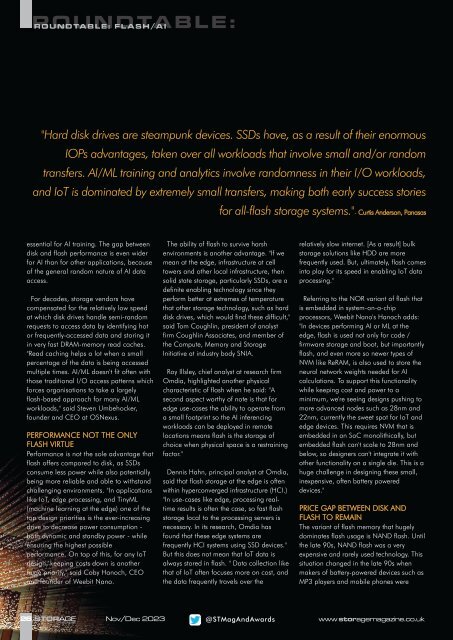ST Nov-Dec 2023
You also want an ePaper? Increase the reach of your titles
YUMPU automatically turns print PDFs into web optimized ePapers that Google loves.
Roundtable 24.qxd 01-<strong>Dec</strong>-23 11:02 AM Page 4<br />
ROUNDTABLE: FLASH/AI<br />
"Hard disk drives are steampunk devices. SSDs have, as a result of their enormous<br />
IOPs advantages, taken over all workloads that involve small and/or random<br />
transfers. AI/ML training and analytics involve randomness in their I/O workloads,<br />
and IoT is dominated by extremely small transfers, making both early success stories<br />
for all-flash storage systems."- Curtis Anderson, Panasas<br />
essential for AI training. The gap between<br />
disk and flash performance is even wider<br />
for AI than for other applications, because<br />
of the general random nature of AI data<br />
access.<br />
For decades, storage vendors have<br />
compensated for the relatively low speed<br />
at which disk drives handle semi-random<br />
requests to access data by identifying hot<br />
or frequently-accessed data and storing it<br />
in very fast DRAM-memory read caches.<br />
"Read caching helps a lot when a small<br />
percentage of the data is being accessed<br />
multiple times. AI/ML doesn't fit often with<br />
those traditional I/O access patterns which<br />
forces organisations to take a largely<br />
flash-based approach for many AI/ML<br />
workloads," said Steven Umbehocker,<br />
founder and CEO at OSNexus.<br />
PERFORMANCE NOT THE ONLY<br />
FLASH VIRTUE<br />
Performance is not the sole advantage that<br />
flash offers compared to disk, as SSDs<br />
consume less power while also potentially<br />
being more reliable and able to withstand<br />
challenging environments. "In applications<br />
like IoT, edge processing, and TinyML<br />
(machine learning at the edge) one of the<br />
top design priorities is the ever-increasing<br />
drive to decrease power consumption -<br />
both dynamic and standby power - while<br />
ensuring the highest possible<br />
performance. On top of this, for any IoT<br />
design, keeping costs down is another<br />
huge priority," said Coby Hanoch, CEO<br />
and founder of Weebit Nano.<br />
The ability of flash to survive harsh<br />
environments is another advantage. "If we<br />
mean at the edge, infrastructure at cell<br />
towers and other local infrastructure, then<br />
solid state storage, particularly SSDs, are a<br />
definite enabling technology since they<br />
perform better at extremes of temperature<br />
that other storage technology, such as hard<br />
disk drives, which would find these difficult,"<br />
said Tom Coughlin, president of analyst<br />
firm Coughlin Associates, and member of<br />
the Compute, Memory and Storage<br />
Initiative at industry body SNIA.<br />
Roy Illsley, chief analyst at research firm<br />
Omdia, highlighted another physical<br />
characteristic of flash when he said: "A<br />
second aspect worthy of note is that for<br />
edge use-cases the ability to operate from<br />
a small footprint so the AI inferencing<br />
workloads can be deployed in remote<br />
locations means flash is the storage of<br />
choice when physical space is a restraining<br />
factor."<br />
Dennis Hahn, principal analyst at Omdia,<br />
said that flash storage at the edge is often<br />
within hyperconverged infrastructure (HCI.)<br />
"In use-cases like edge, processing realtime<br />
results is often the case, so fast flash<br />
storage local to the processing servers is<br />
necessary. In its research, Omdia has<br />
found that these edge systems are<br />
frequently HCI systems using SSD devices."<br />
But this does not mean that IoT data is<br />
always stored in flash. " Data collection like<br />
that of IoT often focuses more on cost, and<br />
the data frequently travels over the<br />
relatively slow internet. [As a result] bulk<br />
storage solutions like HDD are more<br />
frequently used. But, ultimately, flash comes<br />
into play for its speed in enabling IoT data<br />
processing."<br />
Referring to the NOR variant of flash that<br />
is embedded in system-on-a-chip<br />
processors, Weebit Nano's Hanoch adds:<br />
"In devices performing AI or ML at the<br />
edge, flash is used not only for code /<br />
firmware storage and boot, but importantly<br />
flash, and even more so newer types of<br />
NVM like ReRAM, is also used to store the<br />
neural network weights needed for AI<br />
calculations. To support this functionality<br />
while keeping cost and power to a<br />
minimum, we're seeing designs pushing to<br />
more advanced nodes such as 28nm and<br />
22nm, currently the sweet spot for IoT and<br />
edge devices. This requires NVM that is<br />
embedded in an SoC monolithically, but<br />
embedded flash can't scale to 28nm and<br />
below, so designers can't integrate it with<br />
other functionality on a single die. This is a<br />
huge challenge in designing these small,<br />
inexpensive, often battery powered<br />
devices."<br />
PRICE GAP BETWEEN DISK AND<br />
FLASH TO REMAIN<br />
The variant of flash memory that hugely<br />
dominates flash usage is NAND flash. Until<br />
the late 90s, NAND flash was a very<br />
expensive and rarely used technology. This<br />
situation changed in the late 90s when<br />
makers of battery-powered devices such as<br />
MP3 players and mobile phones were<br />
26 <strong>ST</strong>ORAGE <strong>Nov</strong>/<strong>Dec</strong> <strong>2023</strong><br />
@<strong>ST</strong>MagAndAwards<br />
www.storagemagazine.co.uk<br />
MAGAZINE

















